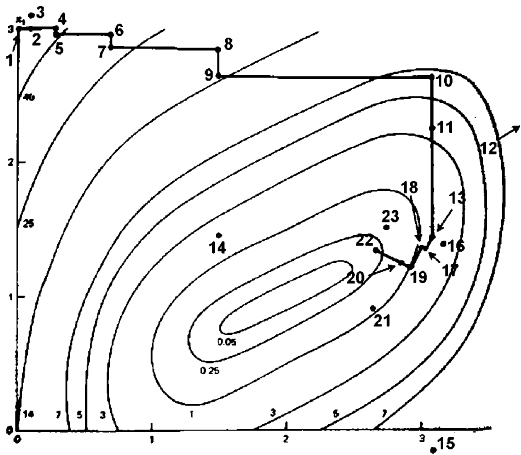



Next: Code
Up: Annexes
Previous: QR factorization
Contents
A simple direct optimizer: the Rosenbrock optimizer
The Rosenbrock method is a  order search algorithm (i.e, it does not require any derivatives
of the target function. Only simple evaluations of the objective function are
used). Yet, it approximates a gradient search thus combining advantages of
order search algorithm (i.e, it does not require any derivatives
of the target function. Only simple evaluations of the objective function are
used). Yet, it approximates a gradient search thus combining advantages of  order and
order and  order strategies. It was published by Rosenbrock [Ros60] in the
order strategies. It was published by Rosenbrock [Ros60] in the  .
.
This method is particularly well suited when the objective
function does not require a great deal of computing power. In such
a case, it's useless to use very complicated optimization
algorithms. We will spend much time in the optimization
calculations instead of making a little bit more evaluations of
the objective function which will finally lead to a shorter
calculation time.
Figure 13.5:
Illustration of the
Rosenbrock procedure using discrete steps (the number denotes the
order in which the points are generated))
 |
In the first iteration, it is a simple  order search in the directions of the base vectors of an n-dimensional
coordinate system. In the case of a success, which is an attempt yielding a new
minimum value of the target function, the step width is increased, while in the
case of a failure it is decreased and the opposite direction will be tried (see
points 1 to 15 in the Figure 13.5).
Once a success has been found and exploited in each base direction, the coordinate
system is rotated in order to make the first base vector point into the direction
of the gradient (in Figure 13.5, the
points 13, 16 & 17 are defining the new base). Now all step widths are initialized
and the process is repeated using the rotated coordinate system (points 16 to
23).
order search in the directions of the base vectors of an n-dimensional
coordinate system. In the case of a success, which is an attempt yielding a new
minimum value of the target function, the step width is increased, while in the
case of a failure it is decreased and the opposite direction will be tried (see
points 1 to 15 in the Figure 13.5).
Once a success has been found and exploited in each base direction, the coordinate
system is rotated in order to make the first base vector point into the direction
of the gradient (in Figure 13.5, the
points 13, 16 & 17 are defining the new base). Now all step widths are initialized
and the process is repeated using the rotated coordinate system (points 16 to
23).
The creation of a new rotated coordinate system is usually done using a Gram-Shmidt
orthogonalization procedure. This algorithm is numerically instable. This instability
can lead to a premature ending of the optimization algorithm. J.R.Palmer [Pal69] has proposed a beautiful solution to this problem.
Initializing the step widths to rather big values enables the strategy to leave
local optima and to go on with search for more global minima. It has turned out
that this simple approach is more stable than many sophisticated algorithms and
it requires much less calculations of the target function than higher order strategies
[Sch77]. This method has also been proved to always
converge (global convergence to a local optima assured) [BSM93].
Finally a user who is not an optimization expert has a real chance
to understand it and to set and tune its parameters properly.
The code of my implementation of the Rosenbrock algorithm is available in the
code section. The code of the optimizer is standard C and doesn't use any special
libraries. It can be compiled under windows or unix. The code has been highly
optimized to be as fast as possible (with extend use of memcpy function, special
fast matrix manipulation and so on...). The improvement of J.R. Palmer is used.
This improvement allows still faster speed. The whole algorithm is only 107 lines
long (with correct indentations). It's written in pure structural programmation
(i.e., there is no ``goto instruction''). It is thus very easy to understand/customize.
A small example of use (testR1.cpp) is available. In this example, the standard
Rosenbrock banana function is minimized.




Next: Code
Up: Annexes
Previous: QR factorization
Contents
Frank Vanden Berghen
2004-04-19

